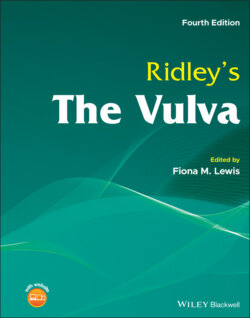Читать книгу Ridley's The Vulva - Группа авторов - Страница 20
Carnegie stages 4–6
ОглавлениеThe blastocyst penetrates and embeds in the uterine endometrium. The outer envelope of cytotrophoblast, forming the wall of the blastocyst, generates the syncytiotrophoblast on its external surface [7] and the extraembryonic mesoderm on its internal surface. This structure is termed the chorion (Figure 1.2a).
The primitive amniotic cavity develops at approximately 7–9 days post ovulation, and its floor forms the primary ectoderm (Figure 1.2b). The primary endoderm is probably formed from cells originating from the ectoderm that migrate around the blastocoelic cavity and enclose the yolk sac. The ectoderm covering the floor of the amniotic cavity and the endoderm forming the roof of the yolk sac are in apposition, and therefore establish the bilaminar embryonic disc (Figure 1.2c). A projection of the yolk sac endoderm into the extraembryonic mesoderm forms the allantoic diverticulum which identifies the caudal end of the bilaminar embryonic disc and the site of the body stalk (Figure 1.2d).
The primitive streak (Figure 1.3a) is formed and lies caudally in the midline of the embryonic disc. The primitive streak subsequently generates the intraembryonic mesoderm, which migrates through the bilaminar embryonic disc, in the plane between ectoderm and endoderm (Figure 1.3b), converting it into a trilaminar disc. The disc remains bilaminar at the caudal and rostral ends. The caudal end forms the cloacal membrane.
Table 1.1 Carnegie stages in early embryogenesis.
| Carnegie stage | Days – post ovulation | Approximate size (mm) | Important events in genital & urological tract embryogenesis |
|---|---|---|---|
| 1 | 1 (week 1) | 0.1–0.15 | Point of fertilisation |
| 2 | 2–3 | 0.1–0.2 | |
| 3 | 4–5 | 0.1–0.2 | Blastocyst forms |
| 4 | 5–6 | 0.1–0.2 | Embeds in endometrium |
| 5 | 7–12 (week 2) | 0.1–0.2 | Allantoic diverticulum formed |
| 6 | 13–15 | 0.2 | Cloacal membrane formed |
| 7 | 15–17 (week 3) | 0.4 | |
| 8 | 17–19 | 1–1.5 | Primordial germ cells present |
| 9 | 19–21 | 1.5–2.5 | Hindgut formed and urogenital septum migrates caudally |
| 10 | 22–23 (week 4) | 2–3.5 | |
| 11 | 23–26 | 2.5–4.5 | Genital tubercle, cloacal folds, and genital swellings form |
| 12 | 26–30 | 3–5 | |
| 13 | 28–32 (week 5) | 4–6 | Urogenital septum divides hindgut into urogenital sinus and rectum |
| 14 | 31–35 | 5–7 | Labioscrotal folds fuse to form perineal body |
| 15 | 35–42 | 7–9 | Indifferent gonad |
| 16 | 37–42 (week 6) | 8–11 | Paramesonephric ducts appear. Trigone of bladder and posterior urethra formed |
| 17 | 42–44 | 11–14 | |
| 18 | 44–48 (week 7) | 13–17 | Embryonic testis develops in male |
| 19 | 48–51 | 16–18 | Bladder and urethra formed |
| 20 | 51–53 (week 8) | 18–22 | Ovary develops |
| 21 | 56–60 | 27–31 | |
| 22 | 54–56 | 23–28 | |
| 23 | 56–60 | 27–31 | External genital primordium developed, but still indeterminate sex |
Figure 1.1 The conceptus is enclosed within an acellular envelope, the zona pellucida. After the formation of the blastocyst and dissolution of the zona pellucida, the characteristic fluid‐filled cavity, the embryonic pole or inner cell mass, and the mural trophoblast can be identified.
Figure 1.2 The conceptus continues to differentiate forming (a) the chorion, (b) the amniotic cavity, and (c) the yolk sac. The area of contact between the amniotic cavity and the yolk sac is the bilaminar embryonic disc. (d) Projection of the yolk sac endoderm into the mesoderm to form the allantoic diverticulum.
